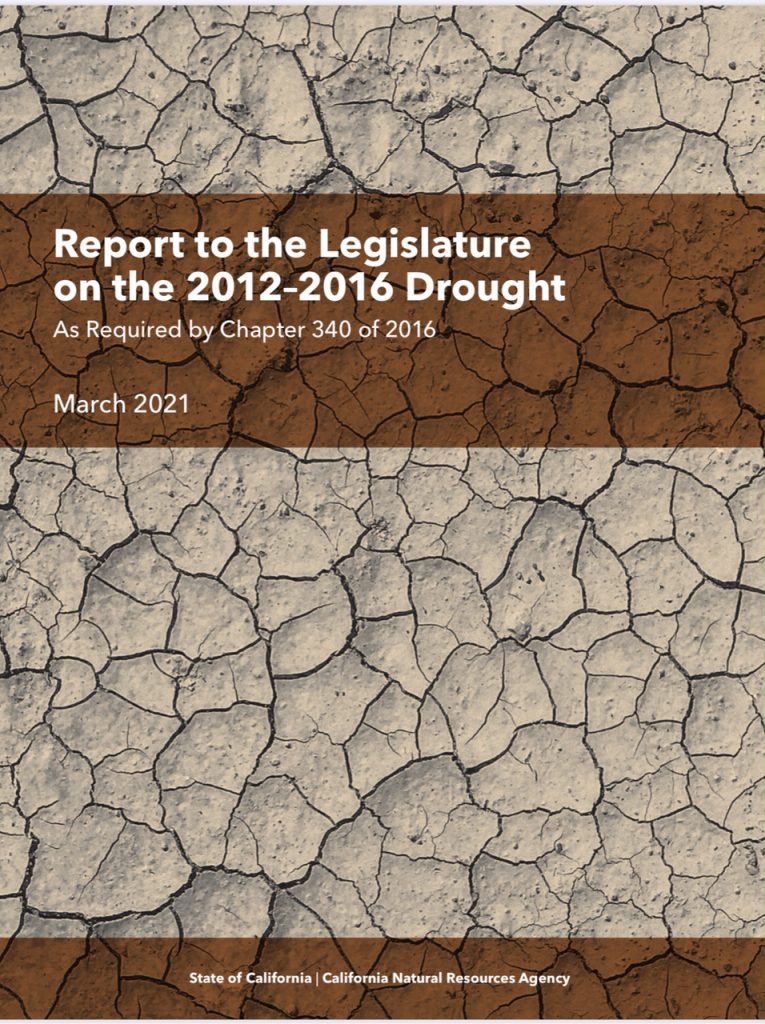Excerpts from the Executive Summary
California’s drought between Water Years 2012 and 2016 was one of the most severe in state history. A string of five dry winters left some rural communities without water, interrupted surface water deliveries to some farmers in the Sacramento and San Joaquin valleys for two consecutive
years, disrupted thousands of farming jobs, pushed some fish populations toward extinction, and created conditions that fueled some of the most catastrophic wildfires in state history.
The State response included actions not taken since the short but intense drought of 1976–1977. For example, water right administrators curtailed thousands of diversions on the mainstem Sacramento and San Joaquin rivers in order to protect fish and wildlife and senior water
right holders.
Distinctive features of this drought included an unprecedented State response to drinking water problems associated with small water systems and private wells, mandatory state-imposed urban water use reduction,
recognition of the cumulative impacts of vast land subsidence in the San Joaquin Valley, massive tree mortality in the central and southern Sierra Nevada, and greatly increased wildfire activity and harmful algal blooms.
The drought revealed some strengths in the State’s largely decentralized systems for managing water. Large urban water districts that had previously invested to diversify their supply sources and build new storage
handled the drought without major disruption, and Californians responded heartily to the Governor’s call for a reduction in water use of at least 25 percent.
But 2012–2016 showed serious problems, too. Water deliveries by the State’s two largest water projects fell to unprecedentedly low levels. Growers turned to groundwater to make up the difference, and heavy pumping triggered record declines in groundwater levels. This accelerated land subsidence in parts of the San Joaquin Valley that in turn continued to damage water supply and flood risk management infrastructure.
State leaders enacted several major legislative and regulatory changes during or after the 2012–2016 drought. These changes:
>require local agencies to bring overdrafted groundwater basins into sustainable conditions by 2042;
» establish new standards for indoor, outdoor, and industrial use of water;
» fund solutions for disadvantaged communities lacking access to safe drinking water;
» increase the frequency of water use reporting;
» give the State authority to order failing public water systems to consolidate with better-run systems; and
» tighten landscape efficiency standards for new developments.
Link to the full report from the California Natural Resources Agency




Pingback: How a California farmer is helping build a Black-led sustainable agriculture revolution – Dikla Akrat
Pingback: California Farmer Dennis Hutson on Sustainable Practices and Using Less Water – News Surgeon
Pingback: How a California farmer is helping build a Black-led sustainable agriculture revolution - Good Day Friends
Pingback: How a California farmer is helping build a Black-led sustainable agriculture revolution – DIGIWIZ CENTRAL
Pingback: How a California farmer is helping build a Black-led sustainable agriculture revolution - eriinfo.com
Pingback: How a California farmer is helping build a Black-led sustainable agriculture revolution - Minnesota Business Insights